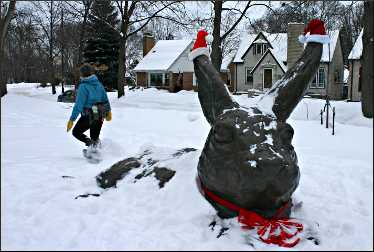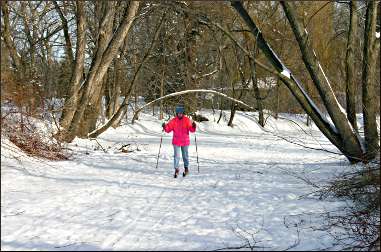Snowshoeing on Minnehaha Creek
In winter, walk through south Minneapolis on a famous creek.

© Beth Gauper
If you're a paddler, you're done for the winter. But when one door closes, another opens.
I've been meaning to paddle Minnehaha Creek through the heart of Minneapolis for years, but the water won't stand still — sometimes it's too high, sometimes too low.
This 22-mile creek, named for a romantic character in an 1855 hit poem, connects everything that makes Minneapolis famous: the Mississippi River, Minnehaha Falls, the Chain of Lakes and Lake Minnetonka.
It's a favorite of paddlers when conditions are right — and of snowshoers in deep winter, when the water freezes.
In Minneapolis, parkland surrounds the last eight miles of the creek. One January, my friend Cathy and I started at Lynnhurst Park on the south end of Lake Harriet.
The outlet from the lake was frozen, but a big flock of ducks was keeping the creek open. On our canoe-route map, we read, "Fish were once so thick in spring at this spot that early settlers used pitchforks to toss them onto the banks."
A little storybook bridge lay beyond the next curve. It was the first of many delightful bridges, some high, some low, many with elegant steel rails and graceful arches.
One craggy limestone bridge was lined by pale slabs that looked like stalactites; another was in the Arts and Crafts style, adorned with square slots that looked like battlements on castle towers.
For a while, we followed the creek on its banks. There are paved trails on both sides, but our snowshoes let us stay close to the creekbed. We passed a snowman with wild straw hair, orange-slice eyes and a pink polka-dot scarf.
Its makers must have come from one of the handsome, half-timbered Tudor houses lining Minnehaha Parkway. In Minneapolis, houses are set back but still part of the scenery; in the affluent Edina and Minnetonka sections of the creek, lined by private estates, they are the scenery.
Near the I-35W bridge, the creek widened and froze, and we walked the rest of the way over solid ice.
An occasional runner passed on the trails, but still we saw only animal tracks on the creek, and a pile of turkey feathers marked an apparent skirmish.
Four plumped-up, bright-red cardinals flitted inside a clump of dogwoods on the bank, then scattered as we advanced.
At Portland, we passed the sculpture "Cottontail on the Trail," a landmark known as the big bronze bunny to hikers. A man and his dog joined us on the creek, and we added our snowshoe prints to ski tracks and mountain-bike treads.

© Beth Gauper
As the creek approaches Lake Nokomis, the banks flattened. We passed the first of two sledding hills, filled with shouting children, then the Cedar Avenue bridge, the first one marked with its name.
We came to a fork at Lake Nokomis and turned toward Hiawatha Golf Course instead of the lake. A sign hung on the next bridge: "Canoeists Caution, Golf Playing Area."
Leaving the golf course, we walked onto the south end of Lake Hiawatha and back onto the creek. There was more open water at 28th Avenue, so we walked along the banks. When I tried again to walk on the creek near some rushes, I broke through — good thing I was wearing waterproof boots.
Then the creek widened and froze solid again. Soon, we saw the back of a sandstone statue of Henry Wadsworth Longfellow, alone in the middle of a meadow, and then the buoy marking the point where paddlers have to get off the creek.
Just beyond is Minnehaha Park and the more famous statue of Minnehaha, held in the arms of her lover Hiawatha. Beyond that, Minnehaha Falls drops into a gorge and the creek flows another mile to the Mississippi River.
In 1822, the 14-year-old son of the commander at Fort Snelling paddled upstream with a runaway drummer boy and portaged around the big falls and onto the creek.
Twenty-one miles later, they became the first Europeans to see Lake Minnetonka. They were the vanguard of a wave of paddlers — and snowshoers — that never has stopped.
Ice trails in other places
Frozen creeks, lakes and rivers are great places to snowshoe in cities and countryside alike. In Chicago, the parks district holds Polar Adventure Days on Northerly Island, across the harbor from Soldier Field.
You could also try snowshoeing on the North Branch of the Chicago River, which barely has a current. On rivers, always stay close to the shore.
In Madison, walk from Lake Monona to Lake Waubesa and to Lake Wingra along Wingra Creek.
On the Mississippi River, use snowshoes to look for bald eagles in sloughs that are way too buggy to explore in summer. Don't go onto the river unless you see ice fishermen there, and even then, be very careful.
In the Boundary Waters, use snowshoes to hike from lake to lake, over portages that are muddy in summer. Be careful on lakes; they freeze at night and thaw during the day, creating a crust that snowshoers might break through to slush.
On Minnesota's North Shore, snowshoe up frozen rivers through gorges. One of the most scenic is the Devil Track River north of Grand Marais, lined by 200-foot cliffs.
The Caribou and Kadunce rivers also are good bets. Bring poles when you have to snowshoe up and down hills.
Lake Superior never is safe, but rangers at Apostle Islands National Lakeshore let people know when they can walk over it to the mainland ice caves.
In Ely, walk to ancient pictographs across frozen Hegman Lake.
For more, see Snowshoeing in Minnesota and Snowshoeing in Wisconsin.
Trip Tips: Snowshoeing Minnehaha Creek
Maps: Download a Minnehaha Creek Canoe Route map or get one from the Minnehaha Creek Watershed District, 952-471-0590.

© Beth Gauper
Where to walk: On the east end of the trail, the four-mile stretch between Lynnhurst Park, on the south end of Lake Harriet, to Lake Nokomis takes about three hours, less if the whole thing is frozen. There's parking at Lake Nokomis Community Center.
There are two good coffee/treat stops on the east end of this stretch: Mel-O-Glaze Bakery at 28th Avenue and Minnehaha Parkway and Nokomis Beach Coffee at 28th Avenue and 50th Street, just off the easternmost part of Lake Nokomis.
It's another two miles to Minnehaha Park. There's free parking at Longfellow Gardens, just across Hiawatha Avenue from the park.
In Minneapolis, parkland adjoins the creek and you can get on anywhere. On the west end of the creek, parkland adjoins the first two miles, and there are landings at Gray's Bay Dam, Jidana Park and the Minnetonka Civic Center.
Much of the creek in the middle is adjoined by private land, but there are landings almost every mile.
Safety: Snowshoes do distribute your weight, making walking on ice safer. But it's best to walk with a friend.
On Minnehaha Creek, there are many places where water flows into the creek and may keep pockets of water open: "There's always a risk because you have the potential of water flowing underneath the ice," says Dr. Udai Singh, water-quality specialist of the Minnehaha Creek Watershed District.
However, the creek is shallow, and you'll just get your feet wet if you break through. If you want to take risks, wear waterproof boots or carry an extra pair of socks and boots in a backpack.
Watch out for clumps of rushes on the banks — they capture snow, which insulates the water. Snowshoers may be more likely to break through there than in the middle of the creek.